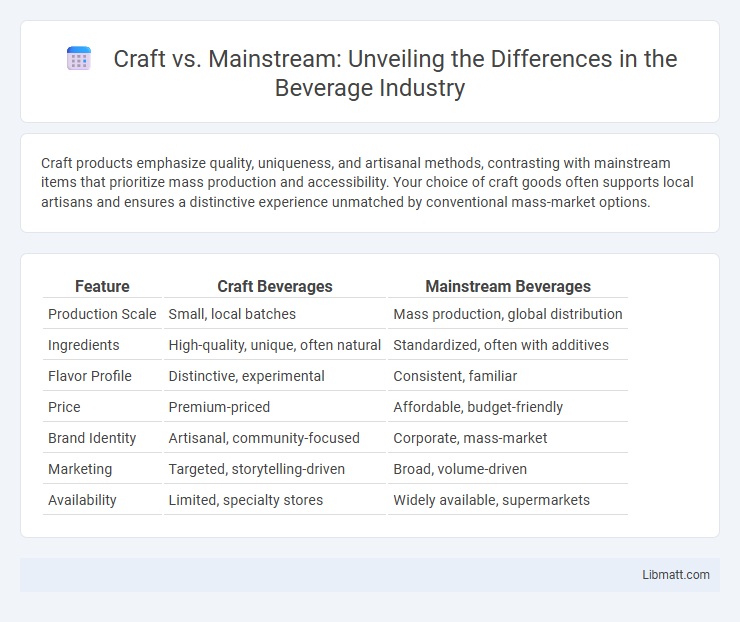Craft products emphasize quality, uniqueness, and artisanal methods, contrasting with mainstream items that prioritize mass production and accessibility. Your choice of craft goods often supports local artisans and ensures a distinctive experience unmatched by conventional mass-market options.
Table of Comparison
| Feature | Craft Beverages | Mainstream Beverages |
|---|---|---|
| Production Scale | Small, local batches | Mass production, global distribution |
| Ingredients | High-quality, unique, often natural | Standardized, often with additives |
| Flavor Profile | Distinctive, experimental | Consistent, familiar |
| Price | Premium-priced | Affordable, budget-friendly |
| Brand Identity | Artisanal, community-focused | Corporate, mass-market |
| Marketing | Targeted, storytelling-driven | Broad, volume-driven |
| Availability | Limited, specialty stores | Widely available, supermarkets |
Understanding Craft vs. Mainstream: Key Differences
Craft products emphasize artisanal quality, small-batch production, and unique, often handmade details, contrasting sharply with mainstream goods that focus on mass production and widespread availability. Craft items typically showcase higher levels of creativity, authenticity, and personalized touches, appealing to niche markets that value distinctiveness over uniformity. Mainstream products prioritize consistency, affordability, and scalability, ensuring broad consumer access but often sacrificing individuality and craftsmanship.
The Origins and Evolution of Craft Movements
Craft movements originated as localized, artisanal responses to industrial mass production, emphasizing handmade quality and traditional techniques. Over time, these movements evolved by integrating modern design principles and innovative materials, differentiating themselves from mainstream commercial products through authenticity and personal expression. Your appreciation for craft highlights the enduring value of skill, heritage, and individuality in a world dominated by standardized goods.
Core Characteristics of Craft Products
Craft products emphasize artisanal skill, unique design, and high-quality materials sourced locally or sustainably. These items often showcase traditional techniques, limited production runs, and a strong connection to cultural heritage. In contrast to mainstream products, craft goods prioritize authenticity, customization, and durability over mass-market appeal.
What Defines Mainstream Brands?
Mainstream brands are defined by their mass-market appeal, consistent product quality, and widespread availability through major retail channels. These brands prioritize standardized production processes and broad marketing campaigns to attract a large consumer base. Your choice often leans towards mainstream brands for reliability, affordability, and ease of access across various regions.
Quality: Craft Artistry vs. Mass Production
Craft artistry emphasizes meticulous attention to detail and the use of high-quality materials, resulting in unique, durable products. Mass production prioritizes efficiency and volume, often sacrificing the individuality and precision found in handmade items. Your choice between the two affects the overall quality and longevity of the final product.
Consumer Perceptions: Craft Authenticity vs. Mainstream Familiarity
Consumers perceive craft products as embodying authenticity through unique flavors, artisanal techniques, and small-batch production, contrasting with the consistent but standardized experience offered by mainstream brands. The appeal of craft lies in its perceived originality and connection to local or traditional values, driving loyalty among niche audiences who prioritize quality over mass availability. Meanwhile, mainstream familiarity assures consumers of reliability and widespread acceptance, often influencing purchasing decisions based on brand recognition and convenience.
Price and Accessibility Comparison
Craft products typically come with higher price points due to artisanal methods and limited production, making them less accessible to a broad audience. Mainstream options benefit from mass production and economies of scale, resulting in more affordable pricing and widespread availability. Your choice between craft and mainstream depends on whether you prioritize unique quality or budget-friendly accessibility.
Impact on Local Communities and Economies
Craft businesses prioritize supporting local communities by sourcing materials locally and creating jobs that strengthen regional economies. Mainstream companies often rely on global supply chains, which can limit economic benefits for individual communities. By choosing craft products, you contribute directly to preserving local culture and stimulating small-scale economic growth.
Marketing Strategies: Niche Storytelling vs. Wider Appeal
Craft brands deploy niche storytelling, emphasizing authentic heritage, artisanal processes, and unique product narratives that resonate deeply with targeted consumer segments. Mainstream brands prioritize marketing strategies with broader appeal, leveraging mass media channels, celebrity endorsements, and standardized messaging to reach extensive, diverse audiences. This contrast shapes consumer perception, where craft marketing cultivates brand loyalty through emotional connection, while mainstream approaches drive volume through widespread visibility.
Future Trends: The Blurring Line Between Craft and Mainstream
The future of beverage and product markets reveals a blurring line between craft and mainstream as large corporations increasingly adopt artisanal techniques and authentic storytelling to appeal to discerning consumers. Craft brands leverage unique, small-batch production methods and local ingredients, driving innovation that influences mainstream offerings. Your choices will benefit from this trend, providing access to diverse, high-quality products that blend traditional craftsmanship with mass-market availability.
Craft vs mainstream Infographic

 libmatt.com
libmatt.com